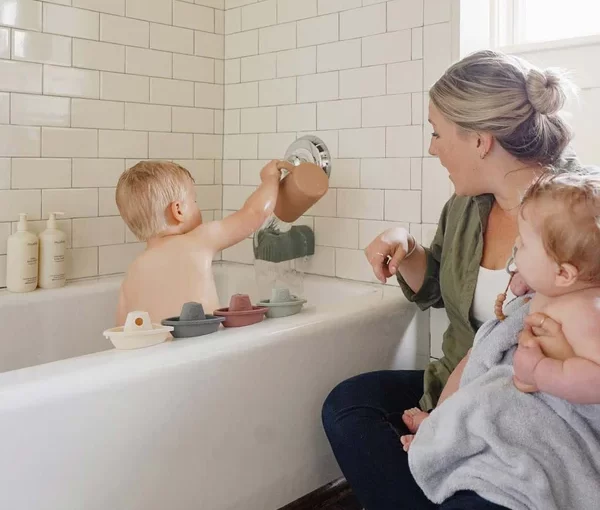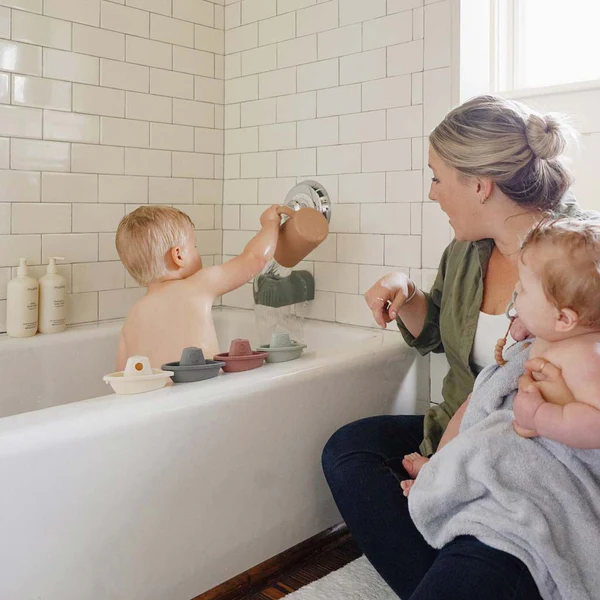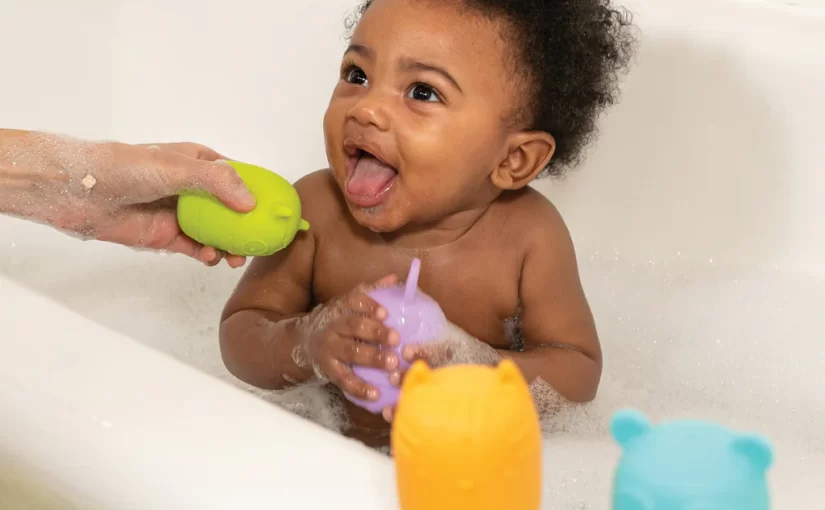The Importance of Keeping Baby Bath Toys Clean
Cleanliness in baby bath toys is crucial for health and safety. Dirty toys can harbor bacteria and mold, posing risks to your child’s well-being. Regular cleaning removes these hazards, ensuring a safe and hygienic play environment. Moreover, clean toys help prevent infections and promote overall health in the sensitive immune systems of babies. Teaching children about cleanliness starts with their immediate surroundings, including their toys. Therefore, ‘how to clean baby bath toys’ is not just about maintaining the toys; it’s about safeguarding your child’s health and instilling good hygiene habits. Clean toys also last longer, protecting your investment and the environment by reducing waste. In essence, keeping baby bath toys clean holds importance far beyond aesthetics; it is about fostering a healthy, happy, and responsible lifestyle from the earliest years of life.
Identifying the Dirt and Grime: What’s Lurking on Your Child’s Toys
Understanding what kind of dirt and grime can accumulate on baby bath toys is the first step in the cleaning process. Bath time fun can leave toys with soap scum, mildew, and biofilm—a slimy layer formed by bacteria. Over time, these elements can create an unhealthy environment for your child. Water toys are especially prone to hidden mold, as water gets trapped inside. Squeeze toys may also release black moldy water after use, which is a clear sign they need cleaning.
Additionally, toys come into contact with a variety of substances. These can range from bath oils and shampoos to bodily fluids like urine. Toys often end up in babies’ mouths, making the need to know how to clean baby bath toys even more critical. Simple visual checks aren’t enough; often, potentially harmful microbes are invisible to the naked eye. By identifying the common culprits, parents can make informed choices about the best methods and products to use for cleaning their child’s bath toys.
Choosing the Right Cleaning Agents for Baby Toys
Selecting safe and effective cleaning agents is vital for your baby’s health. When considering how to clean baby bath toys, look for products that are non-toxic and free from harmful chemicals. Consider using cleaners specifically designed for children’s items, which are usually milder and safer.
Before buying any cleaning agent, always read the label. Check for the absence of phthalates, parabens, and BPA. These substances can potentially harm your child’s health. Also, ensure the product is fragrance-free to avoid the risk of allergies or skin irritation.
Some of the best options include:
- Mild dish soap: Gentle and effective for removing grease and residue.
- White vinegar: A natural disinfectant, it’s excellent for killing mold and mildew.
- Baking soda: Useful for scrubbing and neutralizing odors.
Keep in mind that the safest cleaning agents are often the simplest. There’s no need for aggressive chemicals that might stick to the toys and harm your baby. Instead, focus on natural and approved cleaners that ensure toys are safe to chew on and play with. Always rinse the toys thoroughly with water after using any cleaning agent, and dry them completely to prevent new mold from forming.
Step-by-Step Guide to Cleaning and Disinfecting Bath Toys
Cleaning baby bath toys regularly is key to your child’s health. Follow these steps to ensure the toys stay free of harmful bacteria and mold.
- Gather the Toys: Collect all the bath toys for cleaning. Don’t miss any hiding at the tub’s bottom.
- Prepare a Cleaning Solution: Mix warm water with a mild dish soap or white vinegar. Aim for a natural, non-toxic mix.
- Soak the Toys: Submerge them in the solution. Let them sit for around 15 minutes to loosen grime.
- Scrub the Toys: Use a clean brush or cloth. Focus on removing visible dirt and also inside parts.
- Rinse Well: Run toys under warm water. Make sure all soap or vinegar is gone to prevent irritation.
- Squeeze Out Water: For squeeze toys, flush them out thoroughly. This step is critical to avoid mold.
- Disinfect: Optionally, do a second soak with a mild bleach solution. This kills lingering germs. Remember, only a small amount of bleach is needed.
- Dry Completely: Lay the toys out on a clean towel. Let them air dry fully before the next use.
- Check for Damage: Inspect toys for cracks or breaks. Bacteria can hide in these spots.
- Repeat Regularly: Clean toys at least once a week. More often if they are used daily.
By following this guide on how to clean baby bath toys, you help prevent the buildup of harmful microbes and prolong the life of the toys, making bath time a safe, hygienic, and fun experience for your little one.
Natural and Homemade Solutions for Bath Toy Cleaning
When it comes to how to clean baby bath toys, natural and homemade solutions are often best. They’re safe, cost-effective, and eco-friendly. Here are some easy-to-make options:
- Vinegar and Water Mix: Combine equal parts of white vinegar and water. This solution can cut through soap scum and disinfect toys naturally.
- Baking Soda Paste: Create a paste with baking soda and a little water. Apply it to the toys and scrub. This helps remove tough grime.
- Lemon Juice Spritz: Use lemon juice mixed with water. Spritz on the toys and wipe clean. Lemon has natural cleaning properties.
- Salt Water Soak: Dissolve a tablespoon of salt in hot water. Soak the toys to help kill germs and fungi.
- Tea Tree Oil Blend: Mix a few drops of tea tree oil with water. Tea tree oil is known for its natural antibacterial and antifungal effects.
Always rinse the toys well with clean water after using these solutions. Drying them thoroughly is key to preventing mold growth. Opt for these natural cleaners when thinking about how to clean baby bath toys. They ensure playtime stays safe and fun.
The Role of Smart Bath Toys in Easing Cleaning Routines
In 2025, smart bath toys offer new ways to maintain cleanliness with ease. These innovative toys are designed with hygiene in mind and can signal when they need cleaning or drying. This feature helps parents stay ahead of grime build-up. Many smart toys are also made of materials that resist mold and bacteria, reducing the need for frequent cleanings.
Smart toys may have self-drying capabilities to prevent moisture accumulation. Some toys even come with companion apps that track cleaning schedules, offer reminders, and provide how-to clean baby bath toys tips. These apps take the guesswork out of maintenance and ensure toys are always ready for safe playtime.
With the integration of technology, parents spend less time worrying about cleaning and more time enjoying bath time with their kids. Smart toys not only enhance play but also promote a healthier bath environment for babies. This technological advancement aligns with the ongoing effort to ensure the well-being of children through clean and safe play spaces.
Storing and Maintaining Cleanliness of Bath Toys
Storing bath toys properly is essential for keeping them clean and safe. Here’s what to do:
- Dry the Toys: Make sure bath toys are dry before storing them. This step helps prevent mold.
- Proper Storage Solutions: Use a mesh net or a dedicated toy organizer. Ensure it has good airflow to aid in drying.
- Keep them Accessible but Tidy: Store toys within reach, but keep them off the bathroom floor. This reduces germ exposure.
- Regular Check-ups: Inspect toys during storage for any signs of mold or damage. Discard if necessary.
- Control Humidity: Bathrooms are humid, which can lead to mold growth. Use a dehumidifier to manage moisture levels.
- Rotate Toys: Don’t keep too many toys in the bathroom. Rotating them can reduce wear and keep interest high.
Scheduled cleaning, even for stored toys, is important. Here are some simple maintenance tips:
- Weekly Washing: Clean all bath toys as part of a weekly routine, even if they aren’t used often.
- Sunlight Exposure: Natural sunlight is a great disinfectant. Let toys dry in the sun occasionally.
- Teach Kids: Involve children in the drying and storing process. It teaches responsibility and good hygiene.
By following these storage and maintenance tips, parents can extend the life of baby bath toys and keep bath time fun and hygienic.
Innovative Bath Toy Cleaning Products and Accessories in 2025
The year 2025 has brought remarkable changes to how we clean baby bath toys. With innovation, cleaning has become simpler and more effective. Below are some groundbreaking products that are shaping the future of bath toy maintenance:
- Self-Cleaning Toys: These toys come with materials that repel water and dirt. They use less effort to stay clean.
- UV Light Sanitizers: This tech kills germs on toys quickly and safely. It’s a no-water-needed method.
- Color-Changing Toys: Toys that change color to indicate when they need cleaning. This feature makes maintenance easy.
- Edible Cleaners: These are safe, ingestible cleaning products. If a child puts a toy in their mouth, there’s no harm.
- Robotic Toy Scrubbers: Small robots can scrub and disinfect toys. They are fun and efficient helpers.
- Antibacterial Coatings: Applied to toys, they prevent germ growth. It’s an added layer of protection.
Choosing these innovative products is a smart way to keep toys clean. They save time and ensure a safe environment for children. When considering how to clean baby bath toys, look for these 2025 innovations. They offer both safety and convenience for parents and their kids.





